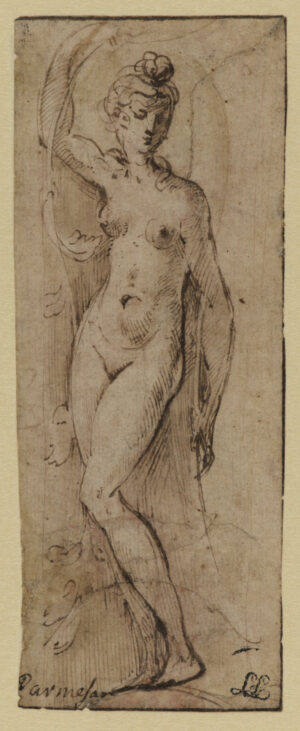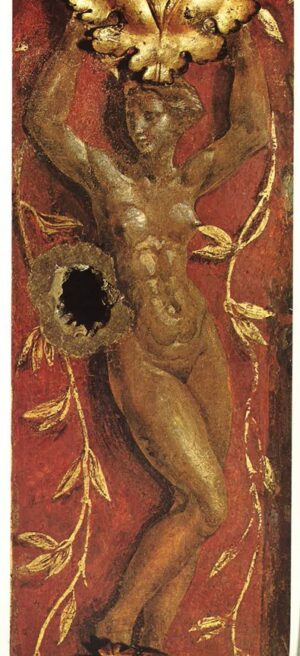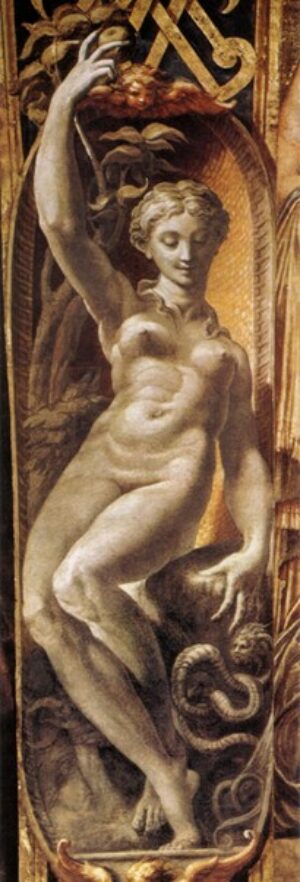As the idealization of female beauty became a central theme in sixteenth century intellectual circles, artists became interested in its representation. Taking inspiration from Petrarchan poetic ideals, Parmigianino is celebrated for his beautiful rendering of the female form.[1] This is perhaps best represented through the large body of preparatory drawings for his work in Santa Maria della Steccata. He spent nearly a decade designing the vault and soffits of the church, of which over a hundred drawings survive.[2]
This drawing is a composite study for several female figures featured in the vault’s design. The sheet is a double-sided drawing where each side represents the same figure in similar poses, one featuring a woman in ink with one arm extended over her head and the other arm at her side, while the second shows the same woman in red chalk with one identically positioned arm and the other delicately bent upward at the elbow. The pen drawing on the recto of the sheet appears to be more finished with stronger and surer outlines, while the chalk drawing is fleshier, and the stomping of the medium allows for more subtle nuances in the figure’s modelling. The chalk drawing has the appearance of a rapid sketch, with emphasis placed less on contours and more on the figure’s proportions.

The most ambitious commission of Parmigianino’s short career was the decoration of the church of Santa Maria della Steccata in the artist’s native Parma. This study of a nude served as the basis for several of the female figures in the barrel vault preceding the apse. There, a row of elongated figures are shown in subtly varied positions, with the gentle twists of their bodies expressing the elegance and grace typical of Parmigianino’s inventions

Verso: This red chalk study is a variation of the standing female nude on the other side of this sheet executed in pen and ink. An ink spot marking the figure’s navel has seeped through to this side of the paper, which Parmigianino used to mark the same feature of his second nude in red chalk. This is an unusually creative approach to developing the two female figures in different positions, both serving the artist as models for the decoration of Santa Maria della Steccata in Parma.

It has been suggested that the figure on the verso of the Courtauld sheet was traced through from the recto’s iron gall design with an alternative position given to one of its arms.[3] This hypothesis is supported by the near perfect correspondence of the outline of one figure to the other, although the physical details and the modelling of the figures are different. Furthermore, an ink mark that has seeped through to the chalk side of the drawing appears to correspond exactly to the navels of both the recto and verso figures. In fact, after close examination, there appears to be media resting on top of the iron gall seepage that corresponds directly with the recto figure’s navel. This would mean that the ink figure’s navel was consciously marked as the verso’s as well. Therefore, the red chalk figure was most likely realized last despite its more sketch-like appearance. Red chalk drawings from Parmigianino’s earlier years reveal how the artist used this medium in diverse manners.[4] He exhibits dynamic contours, with hatching that imitates pen drawing and soft shading, and often combines red chalk with pen, brown wash or white heightening.[5]
Both of these figures bear striking similarities to different components of the commission’s final design of the Santa Maria della Steccata ceiling. (figs. 1-2) They are not for the vault’s main characters but rather provide a composite study of the other female figures of the programme: the small decorative nudes flanking the soffits and the seated figure of ‘Eve’. The decorative nudes are represented holding leafy vines, a motif that is repeated in the drawing’s figures and which is especially drawn out in the ink figure’s design. Both the chalk and ink figures are surely preparatory efforts for the small nudes along the soffits. However, certain details, such as the light outline of a sculptural niche featured on both sides of the drawing, and the positioning of the arms of the iron gall figure, suggest that the sheet was also used as a preliminary drawing for the figure of ‘Eve’.

The multi-The multi-functionality of the drawing, as studies for separate elements of the Steccata vault, offers an interesting testament to Parmigianino’s artistic process. The Courtauld drawing reflects the artist’s ability to construct forms abstractly and to produce figures that exist independently as ornaments with little regard for their correct anatomical proportions.[6]
Parmigianino was very much an artist who thought with his hands and the quality of his draughtsmanship succeeds in conveying the beautiful inventions of his mind. Indeed, Parmigianino appears to have spent an extraordinary amount of effort devising and reworking beautiful figural and decorative ideas for the Steccata.
EG
Footnotes
[1] Cropper 1976, 376.
[2] Bambach in London 2000, 24.
[3] Kirkham in London 1987, 13
[4] Karpati in Budapest 2009, 14
[5] Ibid.
[6] Franklin 2004, p. 229
Bibliography
BUDAPEST 2009
Zoltan Karpati, Parmigianino: The Alchemy of Beauty- Drawings and Prints, exh. cat., Museum of Fine Arts, Budapest, 2009
CROPPER 1976
Elizabeth Cropper, “On Beautiful Women, Parmigianino, Petrarchismo and the Vernacular Style.” The Art Bulletin 58 (1976): 374-96.
FRANKLIN 2004
David Franklin, The Art of Parmigianino. New Haven and London, 2004.
KARPATI 2009
Karpati, Zoltan ed., Parmigianino: The Alchemy of Beauty- Drawings and Prints, exh. cat.,
Museum of Fine Arts, Budapest, 2009.
LONDON 1987
Victoria Kirkham, Parmigianino: Paintings, Drawings, Prints, Courtauld Institute Galleries, London, 1987.
LONDON 2000
Correggio and Parmigianino: Master Draughtsmen of the Renaissance, eds. Carmen C. Bambach, Hugo Chapman, Martin Clayton, and George R. Goldner, exh. cat., London, 2000.
VACCARO 1998
Mary Vaccaro, “Resplendent Vessels: Parmigianino at Work in the Steccata”, ed. Mary Rogers, Concepts of Beauty in Renaissance Art, Ed. Francis Ames-Lewis, Aldershot, 1998, 134-46.
